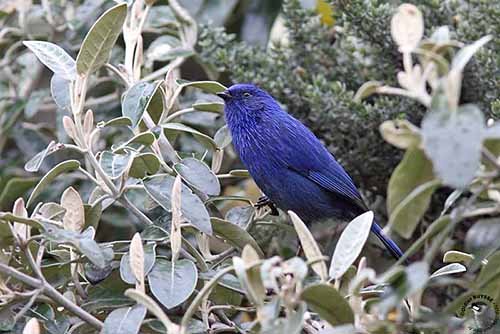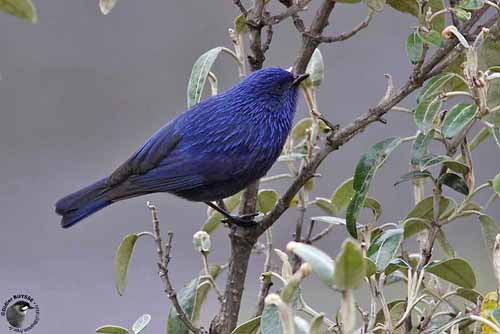
Fr: Xénodacnis mésange
Ang: Tit-like Dacnis
All: Meisenpitpit
Esp: Dacnis Andino - Azulito Altoandino
Ita: Dacne cincia
Nd: Meisedaknis
Sd: mesfink
Photographers:
Didier Buysse
Vision d’Oiseaux
Roger Ahlman
Pbase Galleries Peru and Ecuador
Text by Nicole Bouglouan
Sources:
HANDBOOK OF THE BIRDS OF THE WORLD Vol 16 by Josep del Hoyo- Andrew Elliot-David Christie – Lynx Edicions – ISBN: 9788496553781
A GUIDE TO THE BIRDS OF COLOMBIA by Steven L. Hilty and William L. Brown - Princeton University Press – ISBN 069108372X
BirdLife International (BirdLife International)
Neotropical Birds – Cornell Lab of Ornithology
Wikipedia, the free encyclopaedia
10,000 Birds – Birding, Nature and Conservation, and the wide, wide world
Tit-like Dacnis
Xenodacnis parina
Passeriformes Order – Thraupidae Family
INTRODUCTION:
The Tit-like Dacnis is the sole member of the genus Xenodacnis. The beautiful dark blue male’s plumage differs from the browner and cinnamon-buff female’s colours. The thin, pointed bill involves a diet including insects and nectar.
This species occurs in Ecuador and Peru, and is generally fairly common although mainly locally in woodland at, or above, the tree-line. It is visible up to 4600 metres of elevation in Peru. Three subspecies share the range.
DESCRIPTION OF THE BIRD:
Biometrics:
Nominate race:
Length: 11 cm
Weight: 10-12 g
Other races:
Length: 13 cm
Weight: 11,5-18,5 g
The male of nominate race is dark blue overall with greyish wash above and below. We can see sometimes indistinct silvery streaks on crown, back, rump, throat and central breast.
On the upperwing, lesser and median coverts are dark blue, while greater coverts are dusky with light blue tinge and edges. Flight-feathers and tertials are dusky and edged blue. The tail is dusky with light blue edges.
The thin, sharply pointed bill is blackish. The eyes are dark brown. Legs and feet are dark grey.

The female has blue crown and central nape. The upperparts are pale brownish, with more greyish, washed blue lower back. On the upperwing, the lesser coverts are blue, whereas other coverts and flight-feathers are dusky with indistinct blue tinge. The underparts, including the throat, are cinnamon-buff, fading to buff on belly.
The immature is greyish-brown with dark blue tinge on wings and slightly paler underparts.
SUBSPECIES AND RANGE:
The Tit-like Dacnis has three subspecies.
X.p. bella (here displayed) is found in NC Peru. However, in SC Ecuador, an uncertain race is probably referable to “bella”.
The male is very similar to nominate, but it is dark blue overall and lacks the greyish tinge. The thin silvery streaks are well-visible.
The female has blue forehead, lores and eye’s area, similar to blue mask across the eyes. She has paler underparts than nominate female.
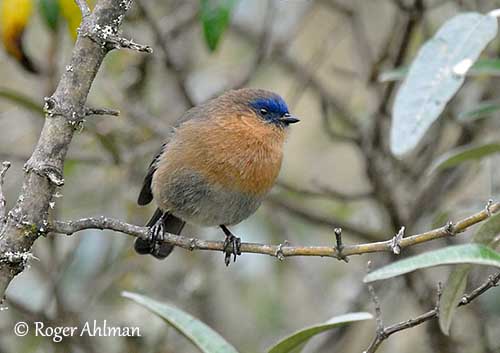
X.p. petersi is found in C Peru, on W slope of the Andes and Lima.
The male differs little from male “bella”, but it is slightly larger and shows brighter silvery streaking.
X.p. parina (described above) occurs in S Peru on E slope of the Andes (Junín, Ayacucho, Apurímac and Cuzco) and on the W slope in Arequipa.
HABITAT:
The Tit-like Dacnis is locally common in shrubbery and patches of stunted woodland, often in Polylepis groves mixed with Gynoxys shrubs.
This species is visible between 3700 and 4000 metres of elevation in Ecuador, and from 3200 up to 4600 metres in Peru.
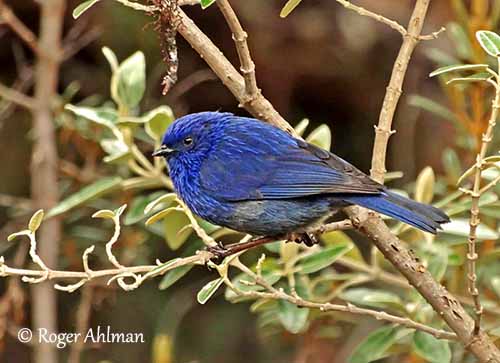
CALLS AND SONGS: SOUNDS BY XENO-CANTO
The Tit-like Dacnis gives surprisingly loud calls and songs. The song is a fast series of penetrating whistles “zwit-zwit-zwit-zhweet-zhweet-zhweet-zhweet” usually interspersed with lower-pitched notes.
The female may join the male in duet. She utters harsher, scratchy notes, continuing after the end of the male’s song.
BEHAVIOUR IN THE WILD:
The Tit-like Dacnis feeds on tiny insects and nectar. Insect diet includes aphids (Aphidoidea). It feeds by gleaning in Gynoxys shrubs, as the underside of the leaves provides aphids. In addition, it also takes other sweet nectar-like secretions excreted by the leaves themselves. It may feed at flowers too. While foraging, it moves quickly from shrub to shrub.
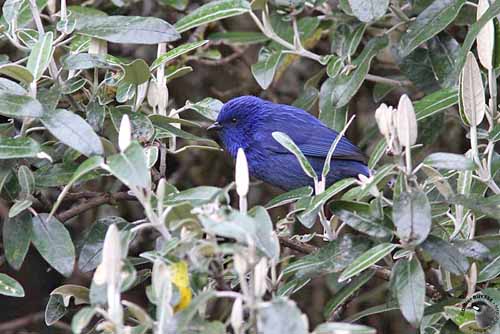
The Tit-like Dacnis can be found in pairs or in small groups. They may occur in high densities (12 or more per hectare in Peru), and the birds defend aggressively their small territories.
They breed in monogamous pairs like most Thraupidae species. The breeding season is closely related to food availability, and usually occurs at the onset of the major rainy season.
Courtship feeding by male to female probably occurs. We can suggest that the blue plumage of the male is enhanced by movements and adapted postures during the displays.
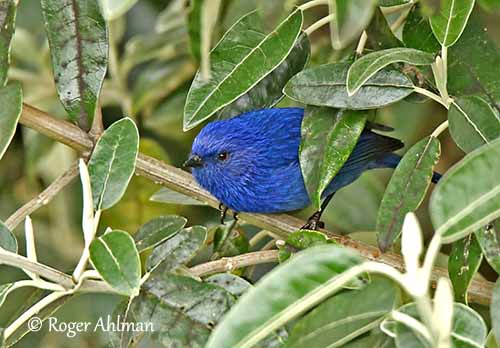
The Tit-like Dacnis is resident in its range. They gather locally in high numbers and do not perform long-distance or altitudinal movements.
The sedentary status of the species is reflected by wing shape and moderate length, but most species are good fliers.
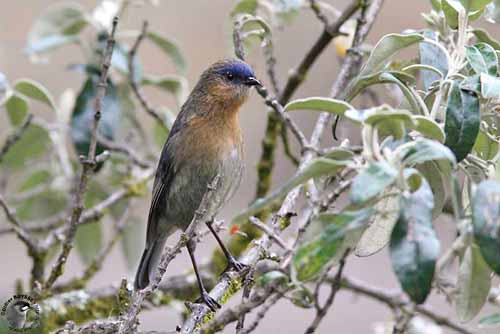
REPRODUCTION OF THIS SPECIES:
More than one brood are attempted during the season if there are abundant food resources.
The tiny cup-shaped nest is made with “wool” from Gynoxys shrubs. It is usually placed in tree, but probably fairly low.
No other information.
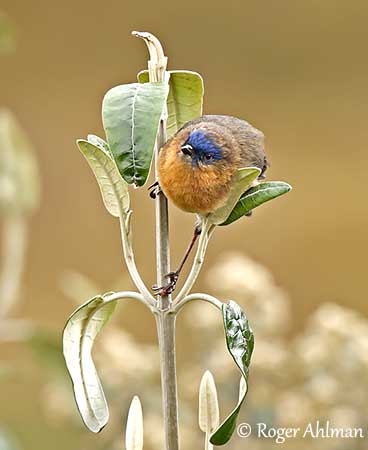
PROTECTION / THREATS / STATUS:
The Tit-like Dacnis is relatively common but patchily distributed in Ecuador and Peru. The species is threatened by fragmentation of its Polylepis habitat and by land clearance and fires, and also by human activities.
With a patchily distribution in the Andes of S Ecuador and Peru, the population is suspected to be in decline, although it can be abundant with a record (Ancash) of “dozens” of birds in a Gynoxys area of less than one hectare.
But in spite of several threats related to the habitat, the Tit-like Dacnis is currently evaluated as Least Concern.
